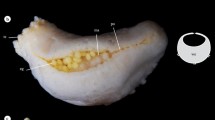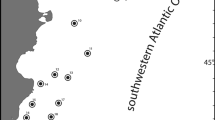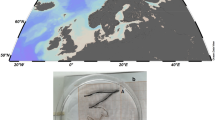Abstract
Brood protection in the holothurianPsolus dubiosus Ludwig and Heding, 1935 was investigated in the Antarctic zone of permanent packice, an environment with an extreme seasonality in planktonic activity. Yearly reproductive cycles on the continental shelf of this area have been poorly investigated. Brooded juveniles of this species were found for the first time between the retracted tentacles of adult females at two different localities in the southeastern Weddell Sea, sampled in spring (October 1986) and autumn (February 1984). Mean lengths of the juveniles of each brooding female showed significant differences within each sample. However, there was no detectable difference in size of the juveniles between the two seasons. The results are discussed as an uncoupling of the dynamics of the early life history of these benthic invertebrates in space and time from processes in the euphotic layer of the Southern Ocean. The species investigated follows the general trend of some Antarctic invertebrates towards a non-pelagic development.
Similar content being viewed by others
Literature cited
Ackermann, G. (1902). Anatomie und Zwittrigkeit derCucumaria laevigata. Z. wiss. Zool. 72: 721–749
Andriashev, A. P. (1977). Some additions to schemes of the vertical zonation of marine bottom fauna. In: LLano, G. A. (ed.) Adaptations within Antarctic ecosystems. Proc. 3rd SCAR Symp. Antarctic Biol., Washington, D. C., August 26–30, 1974. Smithsonian Institution, Washington D.C. Gulf Publishing Co., Houston, p. 351–360
Arnaud, P. M. (1977). Adaptations within the Antarctic marine benthic ecosystem. In: LLano, G. A. (ed.) Adaptations within Antarctic ecosystems. Proc. 3rd SCAR Symp. Antarctic Bio., Washington, D. C., August 26–30, 1974: Smithsonian Institution, Washington D.C. Gulf Publishing Co., Houston, p. 135–157
Arntz, W. E., Brey, T., Gerdes, D., Gorny, M., Gutt, J., Hain, S., Klages, M. (in press) Patterns of life history and population dynamics of benthic invertebrates under high Antarctic conditions of the Weddell Sea. Proc. 24th Eur. mar. Biol. Symp.
Becher, S. (1906). 4. ÜberSynapta minuta n. sp., eine brutpflegende Synaptide der Nordsee, und über die contractilen Rosetten der Holothurien. Zool. Anz. 30: 505–509
Bosch, I., Beauchamp, K. A., Steele, M. E., Pearse, J. S. (1987). Development, metamorphosis, and seasonal abundance of embryos and larvae of the Antarctic sea urchinSterechinus neumayeri. Biol. Bull. mar. biol. Lab., Woods Hole 173: 126–135
Bullivant, J. S. (1967). The fauna of the Ross Sea. Part 5. Ecology of the Ross Sea benthos. Bull. N.Z. Dep. scient. ind. Res. 76: 49–75
Carmack, E. C., Foster, T. D. (1977). Water masses and circulation in the Weddell Sea. In: Dunbar, M. J. (ed.) Polar oceans. Proc. Polar Oceans Conference, Montreal, May 1974. Arctic Institute of North America, Calgary, Alberta, p. 167–177
Cherbonnier, G. (1973). Marine invertebrates collected from Adélie Coast by the 12th and 15th French Antarctic expeditions. 15. Holothuroidea. Téthys 5: 601–610
Clarke, A. (1979). On the lining in cold water: k-strategies in Antarctic benthos. Mar. Biol. 55: 111–119
Clarke, A. (1985). The reproductive biology of the polar hippolytid shrimpChorismus antarcticus at South Georgia. Proc. 18th Eur. mar. Biol. Symp., p. 237–245 [Gray, J. S., Chirstiansen, M. E. (eds.) John Wiley & Sons Ltd., New York]
Cuzin-Roudy, J. (1987). Gonad history of the Antarctic krillEuphausia superba Dana during its breeding season. Polar Biol. 7: 237–244
Dayton, P. K., Robilliard, G. A., Paine, R. T., Dayton, L. B. (1974). Biological accomodation in the benthic community at McMurdo Sound, Antarctica. Ecol. Monogr. 44: 105–128
Dell, R. K. (1972). Antarctic bethos. In: Russel, F., Yonge, M. (eds.) Advances in marine biology, Vol. 10. Academic Press, London, p. 1–216
Ekman, S. (1923). ÜberPsolus squamatus und verwandte Arten. Zugleich ein Beitrag zu Bipolaritätsfrage. Ark. Zool. 15: 1–59
Gieskes, W. W. C., Veth, C., Wöhrmann, A., Gräfe, M. (1987). Secchi disc depth visibility world record shattered. EOS Trans. Am. geophys. Un. 68: 123
Gutt, J. (1991). On the distribution and ecology of holothurians in the Weddell Sea (Antarctica). Polar Biol. 11: 145–155
Gutt, J., Gerdes, D., Klages, M. (in press) Seasonality and spatial variability in the reproduction of two Antarctic holothurians (Echinodermata). Polar Biol.
Hansen, B. (1968). Brood-protection in a deep-sea holothurian,Oneirophanta mutabilis Théel. Nature, Lond. 217: 1062–1063
Hedgpeth, J. W. (1969). Introduction to Antarctic zoogeography. In: Bushnell, V. C., Hedgpeth, J. W. (eds.) Antarctic map folio series 11. American Geographical Society, Washington, D. C., p. 1–9
Helfer, H. (1917). Beitrag zur Kenntnis vonCucumaria laevigata Verrill nebst Beschreibung einer neuen Abart dieser Holothurie. Sber. Ges. naturf. Freunde Berl., 1917: 164–174
Hempel, G. (1985). On the biology of polar seas, particularly the Southern Ocean. Marine biology of polar regions and effects of stress on marine organisms. Proc. 18th Eur. mar. Biol. Symp., p. 3–33 [Gray, J. S., Christiansen, M. E. (eds.) John Wiley & Sons Ltd., New York]
Kohnen, H. (1984). Die Expedition Antarktis-II mit FS „Polarstern“ 1983/84. Bericht von Fahrtabschnitt 4 Punta Arenas-Kapstadt (ANT-II/4). Ber. Polarforsch. Bremerhaven 19: 1–185
Lipps, J. H., Hickman, C. S. (1982). Origin, age, and evolution of antarctic and deep-sea faunas. In: Ernst, W. G., Morin, J. G. (eds.) The environment of the deep sea, Vol 2. Prentice Hall Inc., Englewood Cliffs, p. 324–356
Ludwig, H. (1897a). 4. Brutpflege beiPsolus antarcticus. Zool. Anz. 20: 237–239
Ludwig, H. (1897b). 4. Ein neuer Fall von Brutpflege bei Holothurien. Zool. Anz. 20: 217–219
Ludwig, H. (1904). Brutpflege bei Echinodermen. Zool. Jb., Suppl. 7: 683–699
Ludwig, H., Heding, S. (1935). Die Holothurien der Deutschen Tiefsee-Expedition. 1. Fußlose und dendrochirote Formen. Wiss. Ergebn. dt. Tiefsee-Exped. ‘Validivia’ 24(2): 123–214
Luxmoore, R. A. (1982). The reproductive biology of some serolid isopods from the antarctic. Polar Biol. 1: 3–11
Magniez, P. (1983). Reproductive cycle of the brooding echinoidAbatus cordatus (Echinodermata) in Kerguelen (Antarctic Ocean): changes in the organ indices, biochemical composition and caloric content of the gonads. Mar. Biol. 74: 55–64
Ohshima, H. (1916). A new case of brood-caring in holothurians. Annotnes zool. jap. 9: 121–124
Osorio, C. R., San Martin, A. (1985).Displasterias brucei (Koehler, 1908), Asteroideo incubador de islas elefante, Antarctic chlena (Echionodermata, Asteroidea, Asteriidae) Série cient. Inst. anarct. chil. 32: 99–102
Östergren, H. (1912). Über die Brutpflege der Echinodermen in den südpolaren Küstengebieten. Z. wiss. Zool. 101: 325–341
Pearse, J. S. (1965). Reproductive periodicies in several contrasting populations ofOdontaster validus Koehler, a common Antarctic asteroid. Antarctic Res. Ser. 5: 39–85
Pearse, J. S. (1969). Slow developing demersal embryos and larvae of the Antarctic sea starOdontaster validus. Mar. Biol. 3: 110–116
Pearse, J. S., McClintock, J. B., Bosch, I. (1991) Reproduction of Antarctic benthic marine invertebrates: tempos, modes, and timing. Am. Zool. 31: 65–80
Petersen, G. H. (1989). Benthos, an important compartment in northern aquatic ecosystems. In: Rey, L., Alexander, V. (eds.) Proceedings of the sixth conference of the comité arctique international 13–15 May 1985. E. J. Brill, Leiden, p. 162–176
Picken, G. B. (1980). Reproductive adaptation of Antarctic benthic invertebrates. Biol. J. Linn. Soc. 14: 67–75
Picken, G. B. (1985). Benthic research in Antarctica: past, present and future. Proc. 18th Eur. mar. Biol. Symp., p. 167–184 [Gray, J. S., Christiansen, M.E. (eds.) John Wiley & Sons Ltd., New York]
Richardson, M. G. (1979). The ecology and reproduction of the brooding antarctic bivalveLissarca miliaris. Br. Antarct. Surv. Bull. 49: 91–115
Rutherford, J. C. (1973). Reproduction, growth and mortality of the holothurianCucumaria pseudocurata. Mar. Biol. 22: 167–176
Schnack-Schiel, S. (1987). Die Winter-Expedition mit FS „Polarstern“ in die Antarktis (ANT V/1–3). Ber. Polarforsch. (Bremerhaven) 39: 1–259
Strübing, K. (1982). Die Zugänglichkeit von Forschungsstationen am Rande der Weddellsee in Abhängigkeit von den Meereisverhältnissen. In: Proc. Intermaritec '82, Hamburg: Int. Kongress für Meeresforschung, Schiffs- und Meerestechnik, 431–443
Studer, T. (1876). Über neue Seethiere aus dem antarktischen Meere. Mitt. Naturforsch. Ges. Bern: 75–84
Thomson, C. W. (1878). Notice of some peculiarities in the mode of propagation of certain echionoderms of the Southern Sea. J. Linn. Soc. 13: 55–79
Thorson, G. (1950). Reproductive and larval ecology of marine bottom invertebrates. Biol. Rev. 25: 1–45
Vaney, C. (1906). Deux nouvelles holothuries incubatrices. C. r. Ass. fr. Avanc. Sci., 35th Sess. Lyon: 125–126
Voß, J. (1988). Zoogeographie und Gemeinschaftsanalyse des Makrozoobenthos des Weddellmeeres (Antarktis). Ber. Polarforsch. (Bremerhaven) 45: 1–145
White, M. G. (1970). Aspects of the breeding biology ofGlyptonotus antarcticus (Eights) (Crustacea; Isopoda) at Signey Island, South Orkney Islands. In: Holdgate, M. W. (ed.) Antarctic ecology, Vol. 1. Academic Press, London p. 279–285
White, M. G. (1977). Ecological adaptations by Antarctic poikilotherms to the polar marine environment. In: Llano, G. A. (ed.) Adaptations within antarctic ecosystems. Proc. 3rd SCAR Symp. Antarctic Biol., Washington, D. C., August 26–30, 1974. Smithsonian Institution, Washington D. C. Gulf Publishing Co. Houston, p. 197–208
White, M. G. (1984). Marine Benthos. In: Laws, R. M. (ed.) Antarctic ecology, Vol. 2. Academic Press, London p. 421–461
Author information
Authors and Affiliations
Additional information
Communicated by O. Kinne, Oldendorf/Luhe
Rights and permissions
About this article
Cite this article
Gutt, J. Investigations on brood protection inPsolus dubiosus (Echinodermata: Holothuroidea) from Antarctica in spring and autumn. Mar. Biol. 111, 281–286 (1991). https://doi.org/10.1007/BF01319710
Accepted:
Issue Date:
DOI: https://doi.org/10.1007/BF01319710




